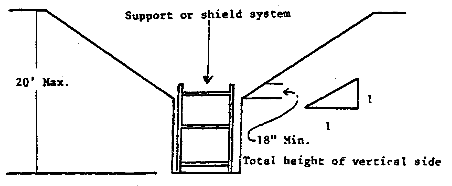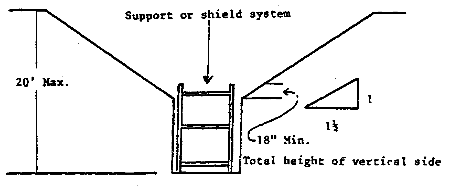
| U.S. Department of Labor |  |
|||||
| Occupational Safety & Health Administration | ||||||
|
Standard Interpretations
10/17/2000 - Requirements to prevent trench collapse during sheet-pile operations. |
|
|
| • Standard Number: | 1926.603(c)(3); 1926.652(b); 1926.651(j) |
October 17, 2000 Mr. Charles Walling Hawkins Construction Company P.O. Box 9008, Station C Omaha, NE 68109 RE: 1926.603(c)(3), 1926.650, 1926.651(g), 1926.651(j)(1), (j)(2), 1926.652, 1926.652(b)(1)(i) & (b)(1)(ii), angle of repose, maximum allowable slope, minimum sheet-pile height above grade, benching Dear Mr. Walling: This is in response to your letter dated March 27, 2000, addressed to the Occupational Safety and Health Administration. You requested an interpretation of 29 CFR 1926.603(c)(3) concerning excavations associated with the use of pile driving equipment. We have paraphrased your questions below: Question (1): In Subpart O (Motor vehicles, mechanized equipment, and marine operations), §1926.603(c)(3) states: "when piles are being driven in an excavated pit, the walls of the pit shall be sloped to the angle of repose or sheet-piled and braced." What angle is the "angle of repose"? When using pile driving equipment in an excavated pit, do I have to comply with the slope angles specified in Subpart P for the various soil classifications? Answer: The required angle of repose for sloping are the angles specified in 29 CFR 1926 Subpart P. Although Subpart O does not define "angle of repose," the term generally refers to the angle between the horizontal and the maximum slope that a soil type assumes through natural processes (see volume 54 of the Federal Register at page 45,896, October 31, 1989). In Subpart P, OSHA addressed the hazard of collapse due to excavation walls exceeding the angle of repose. Because the angle of repose is different for stable rock and the various types of soil, we specified different slope angles for stable rock and soil types A, B, and C in Subpart P's Appendix B, Table B-1. Before 1989, Subpart P, like Subpart O, used the term "angle of repose." For clarity, in our 1989 revision to Subpart P, when we replaced that term with Table B-1, we should have also replaced it in Subpart O with a reference to Table B-1. Nonetheless, since Subpart P addresses the hazard of excavation collapse, the requirements of Subpart P must (at a minimum) be complied with whenever employers use sloping to prevent excavation wall collapse. Subpart O addresses the added hazards of wall collapse posed by the use of pile driving equipment in an excavated pit. Under Subpart O, when using such equipment, the employer's options for protecting employees from wall collapse are more limited than those in Subpart P. Under Subpart P, aside from the sloping and benching options, employers may choose among various means of shoring (see §1926.652). However, when using pile driving equipment in an excavated pit, Subpart O limits the employer's options to sloping or sheet-piling and bracing the walls. Subpart P provides four options for sloping requirements, depending in part on the three soil classifications (Type A, B, or C), identified in Appendix A of Subpart P. The classifications are determined by the soil's strength and relative cohesiveness. The determination of the soil type must be made by a competent person (defined in §1926.650 as one who is capable of identifying existing and predictable hazards in the surroundings or working conditions which are unsanitary, hazardous, or dangerous to employees and who has authorization to take prompt corrective measures to eliminate them). Option one, §1926.652(b)(1), which can be used in all excavations, requires using an angle not steeper than 1½ (horizontal) to 1 (vertical), which is 34 degrees measured from the horizontal. This is the most conservative angle for the allowable slope and can be used in all soil types, including type C. Option two, §1926.652(b)(2), provides the alternative of using Appendices A and B for excavations of 20 feet or less. These provide slope angles depending on the particular soil classification. If the competent person determines that the site's soil is classified as either rock or other than type C soil (Type A or B), an angle larger than 34 degrees, based on §1926.652, can be selected for the maximum allowable slope. Option three, §1926.652(b)(3), permits the allowable slope angle to be selected from tabulated data, such as tables and charts that are approved by a registered professional engineer. The tabulated data must be in written form and include all of the following: (a) identification of the parameters that affect the selection; (b) identification of the limits of use of the data; and (c) explanatory information as may be necessary to aid the user in making the correct selection. Option four, §1926.652(b)(4), permits the allowable sloping and benching system to be "design[ed] by a registered professional engineer." Question (2): Is there a minimum length that sheet-pile must extend above an excavated pit? Answer: Neither Subpart O nor Subpart P requires a minimum length or height for the sheet-piling to extend above the surface grade of an excavation. Sheet-piling is a type of shield or support system. The general standard regulating the design, manufacture, installation, and removal of a shield system is in Subpart P, §§1926.652(c), (d), (e), and (g). There is a situation (in each of the three soil classifications) where Subpart P requires that a shield extend a minimum length above the top of a vertical side of a pit. For excavations less than 20 feet, which have vertically sided lower portions, as shown in Appendix B's Figures B-1.1, B-1.2, and B-1.3, a shield or support must extend to a height of at least 18 inches above the top of the vertical side. [see illustrations in the Attachment] For excavations greater than 20 feet, a registered engineer will be required, as explained under options three and four above, and any minimum sheet-pile height requirements will be indicated on the registered professional engineer's site plans. In these situations, the extended sheet-pile protects the workers from objects or debris falling in the pit. Under §1926.651(j)(1), such employee protection is also provided by scaling the slopes to remove loose material from the face that could pose a hazard by falling or rolling into the excavation. Additionally, under §1926.651(j)(2), employee protection must be provided by placing and keeping materials and equipment at least 2 feet from the edge of the excavation. Question (3): Can benching be used in conjunction with sheet-piles, when the excavated pit is located at the base of a deep slope? If so, would soil classification dictate the depth of vertical and horizontal benches? Answer: Yes, benching can be used in conjunction with sheet-piles regardless of soil classification. You must remember, however, that option two (Appendix A and B) noted above are for excavated pits which have a maximum depth of 20 feet. In making that measurement, you must start from the original grade, not at the base of the slope as your question otherwise suggests. An excavation greater than 20 feet deep, under options three and four, must be designed by a registered professional engineer. The preamble to Subpart P (volume 54, of the Federal Register at page 45902, October 31, 1989) further explains the agency's requirements for using a registered professional engineer when unusual site conditions are encountered. These figures are for excavations in which the surface grade elevation is higher than the lower piling excavation. Section 1926.652 does not provide sheet-piling height requirements for excavations greater than 20 feet. Any minimum height requirements will be indicated on the registered professional engineer's site plans, which are to be maintained at the jobsite. If you need additional information, please do not hesitate to contact the Occupational Safety and Health Standard Administration (OSHA) [Office of Construction Standards and Guidance USDOL/OSHA Room N3468, 200 Constitution Avenue, N.W. Washington, D.C. 20210 at (202) 693-2020] Sincerely, Russell B. Swanson, Director Directorate of Construction [Corrected 05/28/04] ATTACHMENT
B-1.1 Excavations made in Type A soil

B-1.2 Excavations Made in Type B Soil 
B-1.3 Excavations Made in Type C Soil 
|
|
|
| www.osha.gov | www.dol.gov | |
Contact Us | Freedom of Information Act | Customer Survey Privacy and Security Statement | Disclaimers |
||
| Occupational Safety & Health Administration 200 Constitution Avenue, NW Washington, DC 20210 |
||